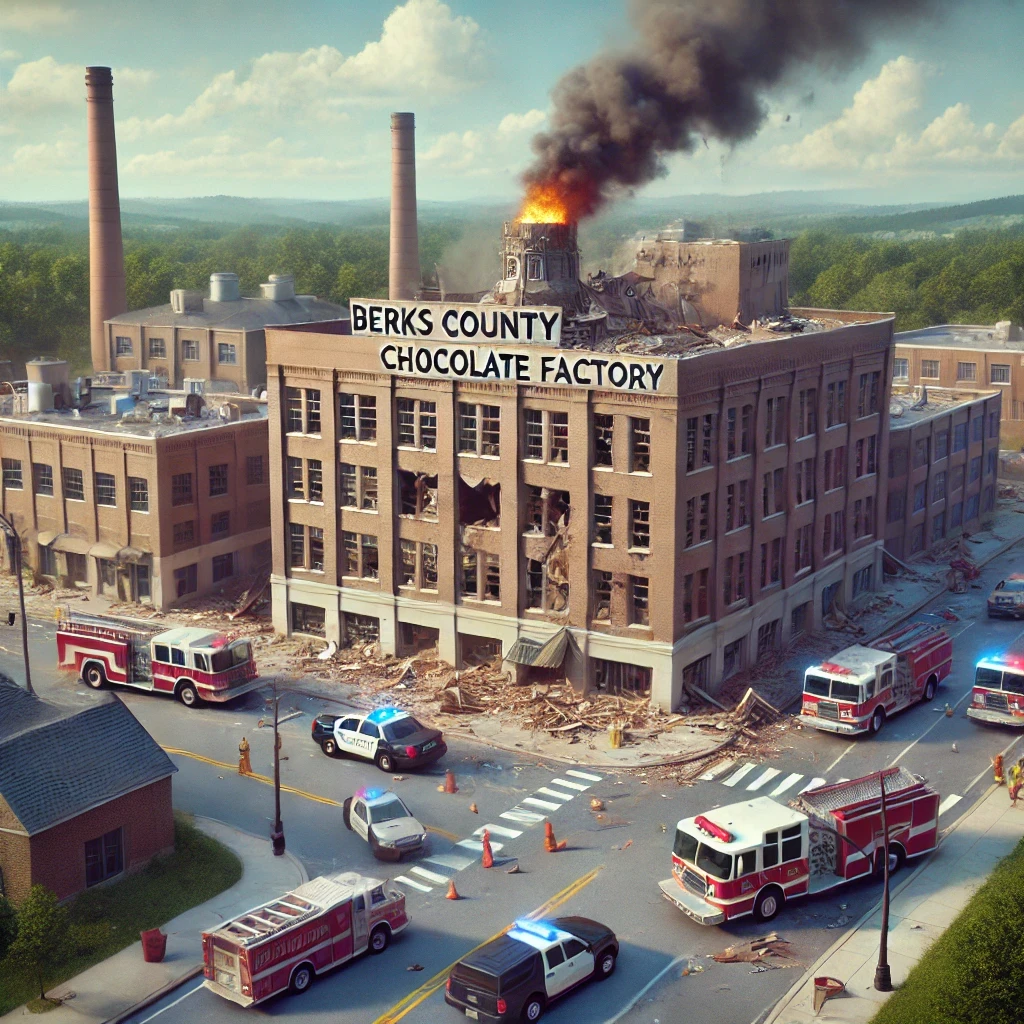Federal Investigation Reveals Multiple Safety Failures Led to Seven Deaths at Pennsylvania Plant
The National Transportation Safety Board determined Tuesday that a combination of corroded infrastructure and inadequate emergency procedures caused the deadly 2023 explosion at R.M. Palmer chocolate factory in West Reading, Pennsylvania. The blast, which killed seven workers and caused $42 million in damage, started when a corroded steam pipe overheated a gas fitting that eventually cracked and leaked. Investigators found that both the utility company UGI Corp. and R.M. Palmer failed to address known safety risks, including reports of gas odors before the explosion.
5 Key Points
- A cracked steam pipe overheated a natural gas fitting, causing gas to leak into the building’s basement.
- UGI crews knew about potential risks from the steam pipe in 2021 but failed to notify safety managers.
- Seven workers died when R.M. Palmer failed to evacuate despite employee reports of gas odors.
- The explosion caused $42 million in damage, destroying one building while severely damaging another.
- NTSB found the factory’s emergency response procedures need to be revised even after revisions.
Infrastructure Failures Traced to Years of Oversight Problems
The NTSB investigation revealed a complex chain of events that began long before the explosion. In 2021, UGI crews replacing gas lines discovered Palmer’s steam pipe but should have notified safety managers about potential risks to nearby gas infrastructure. The steam pipe, already severely corroded then, eventually cracked and released steam near a UGI gas fitting. This fitting, manufactured by DuPont, belonged to a product line with a documented history of cracking under high-temperature conditions. The NTSB noted that many utilities across the country might need to effectively track the locations of these vulnerable fitter things. The combination of the steam leak and the temperature-sensitive fitting created conditions that allowed gas to seep into the basement of Palmer’s second building. However, investigators could not determine the specific ignition source. The explosion sent flames more than 40 feet into the air, demonstrating the catastrophic nature of the infrastructure failure.
Critical Safety Protocols Failed at Multiple Levels
The investigation exposed serious flaws in both companies’ safety systems. UGI’s emergency response could have been improved by improperly marked gas valves, including a critical valve that had been paved over, which delayed efforts to shut off the gas after the explosion. The utility’s distribution integrity management program failed to address the known threat posed by the steam pipe despite the 2021 pipeline replacement project offering an opportunity to remediate the faulty fitting. At Palmer’s facility, approximately 105 employees – including 70 production workers and 35 office staff – were working in two adjacent buildings when workers reported gas odors. The NTSB found that Palmer’s emergency procedures were “insufficient,” and employees “did not understand the hazard and did not evacuate the buildings before the explosion.” The agency’s statement of probable cause directly criticized Palmer’s inadequate emergency response procedures and training, noting that proper protocols could have prevented loss of life.
Post-Incident Response Reveals Systemic Problems
Palmer’s response to the tragedy has drawn sharp criticism from federal investigators. While the company said it “takes the health, safety and wellness of our employees very seriously,” NTSB Chair Jennifer Homendy criticized Palmer’s revised evacuation policy. The new policy still advises staff to investigate and determine if evacuation is necessary – the same approach that proved fatal in the explosion. “That’s exactly what they did in this scenario,” Homendy said. “‘No, you leave.’ Now, their response is they have other smells in their building because chocolate is being made. You know the difference between natural gas smell and chocolate. ‘Get out, immediately.'” The force of the explosion destroyed one building entirely and heavily damaged another, resulting in $42 million in property damage. UGI spokesperson John Mason stated the company “continues to work with customers that also operate underground steam lines, to make sure their systems and our natural gas systems can operate safely together.” However, the NTSB found this coordination needing improvement before the incident.
Industry-Wide Safety Issues Signal Broader Problems
NTSB board member J. Todd Inman connected the Palmer explosion to a broader pattern of industry safety failures, comparing it to a 1996 blast at a shoe store in San Juan, Puerto Rico, that killed 33 people. Federal regulators have warned for decades about the vulnerability of plastic pipes manufactured for natural gas service from the 1960s through the early 1980s, yet these issues persist. Attorney Andrew Duffy, representing explosion victims in civil litigation, emphasized the gravity of UGI’s oversight: “They knew that this was dangerous, brittle piping for decades. It should have been remediated. It’s a shocking failure in an industry whose sole responsibility is safely transporting gas through pipelines.” The NTSB issued new recommendations, including requiring gas leak detection alarms in buildings served by natural gas, but implementation remains voluntary. These recommendations also extend to regulatory agencies and state governments, suggesting a need for comprehensive reform in how industrial facilities manage gas safety.
FAQ
Q: Can I file a lawsuit if a loved one died in an accident caused by negligence?
A: If you lost a loved one due to an accident caused by someone else’s negligence, you may be eligible to file a wrongful death lawsuit. Contact our legal experts to learn about your rights and start a free, confidential case review.
Q: What exactly caused the R.M. Palmer chocolate factory explosion?
A: According to the NTSB, a corroded steam pipe at Palmer cracked and released steam that overheated a nearby UGI gas fitting. This gas fitting failed, allowing gas to leak into the basement, eventually exploding.
Q: Could this explosion have been prevented?
A: Yes. The NTSB identified multiple opportunities to prevent the tragedy, including when UGI crews noticed the steam pipe in 2021 but failed to report it to safety managers. Additionally, immediate evacuation when workers reported gas smells could have prevented the loss of life.
Q: Why didn’t workers evacuate when they smelled gas?
A: The NTSB found that Palmer’s emergency procedures needed to be improved, and employees needed to be adequately trained to understand the hazard. The company’s policy required investigation of gas smells rather than immediate evacuation, a procedure the NTSB chair criticized as dangerous.
Q: Are other buildings at risk from similar gas line issues?
A: Potentially. The NTSB noted that the failed gas fitting, manufactured by DuPont, has a known tendency to crack and is still in widespread use nationwide. Many utilities may need to know where these vulnerable fittings are located in their systems.
Q: What changes are being recommended to prevent future explosions?
A: The NTSB recommends installing gas leak detection alarms in all buildings served by natural gas, improving utility protocols for temperature-vulnerable piping, and enhancing emergency response procedures. For Palmer specifically, the board recommends revising their evacuation policy to require immediate evacuation when gas is detected.
Q: How many people were affected by the explosion?
A: Seven workers were killed in the explosion. At the time of the blast, approximately 105 employees were present – 70 production workers and 35 office staff. The explosion also caused $42 million in property, destroying one building and heavily damaging another.
Citations
Michael Rubinkam (December 10, 2024). R.M. Palmer Chocolate Factory Explosion Cause: Gas Leak, NTSB Report. NBC Philadelphia. https://www.nbcphiladelphia.com/news/local/r-m-palmer-chocoloate-factory-explosion-cause-gas-leak-ntsb-report/4050991/







